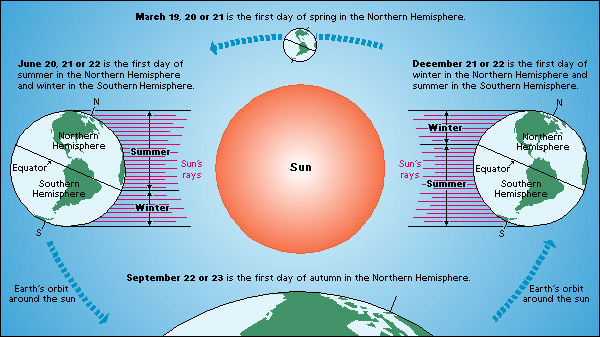Season is a period of weather, agricultural activity, or events that repeats each year. The word season comes from the Latin word for sowing, a reference to the yearly period of planting. People commonly divide the year into seasons based on the typical weather at various times. Four such seasons—spring, summer, autumn, and winter—occur throughout much of the world. Meteorologists (scientists who study the weather) also use such terms as tornado season, hurricane season, and wildfire season to describe periods when these events commonly occur. Farmers speak of the growing season, during which they raise crops, and the harvest season, in which they gather them. Members of many religions observe special seasons as part of a calendar of religious events. The rest of this article discusses seasons of weather.
The four seasons
result from the tilt of Earth’s axis of rotation and the planet’s motion around the sun. The axis slants at an angle of 23 degrees 27 minutes in relation to the plane of Earth’s orbit. As a result, Earth’s Northern and Southern hemispheres tilt toward or away from the sun during different times of the year. Some people mistakenly believe that seasons result from Earth moving closer to or farther from the sun at different times of the year. But Earth orbits at nearly the same distance from the sun throughout the year. The small changes in distance that do occur have little effect on Earth’s weather.

Summer occurs in the Northern or Southern hemisphere when that hemisphere is tilted toward the sun. As a result, places in the hemisphere receive more than 12 hours of sunlight each day. The sun also appears higher in the sky. Its light strikes Earth’s surface at a more direct angle and so delivers more concentrated energy. The greater amount and concentration of sunlight lead to higher temperatures. During winter, the hemisphere tilts away from the sun. As a result, places in it receive less than 12 hours of sunlight each day and the light is less direct, leading to lower temperatures.
Most people mark the beginning of summer or winter as the times when Earth’s axis has its greatest tilt toward or away from the sun. At these two moments, called the solstices, the sun appears at its northernmost or southernmost position in the sky. At the June solstice, which occurs on June 20, 21, or 22, the sun reaches its most northerly point, directly overhead at the Tropic of Cancer, an imaginary line at 23 degrees 27 minutes north latitude. In the Northern Hemisphere, the June solstice marks the beginning of summer. In the Southern Hemisphere, winter begins. At the December solstice, on December 21 or 22, the sun lies directly overhead at the Tropic of Capricorn, at 23 degrees 27 minutes south latitude. The December solstice marks the beginning of summer in the Southern Hemisphere and the start of winter in the Northern Hemisphere.

Spring and autumn begin at the two times of the year when the sun lies directly overhead at the equator. These moments are known as the equinoxes. On the days of the equinoxes, all places on Earth receive approximately 12 hours of sunlight. The March equinox marks the start of spring in the Northern Hemisphere and the beginning of autumn in the Southern Hemisphere. It occurs on March 19, 20, or 21. The September equinox, which occurs on September 22 or 23, marks the beginning of spring in the Southern Hemisphere and the start of autumn in the Northern Hemisphere.
At some times of the year, areas near Earth’s poles have extended periods of sunlight or darkness. On the June solstice, all places along the Arctic Circle, which lies at 66 degrees 33 minutes north latitude, receive 24 hours of sunlight. Regions farther north have progressively more days of constant sunlight. The North Pole has six months of continuous sunlight from the March equinox until the September equinox. During this period, the South Pole has six months of nearly continuous darkness. During the other half of the year, areas south of the Antarctic Circle, which lies at 66 degrees 33 minutes south latitude, get at least one day of constant sunlight. The South Pole has six months of continuous sunlight, while the North Pole is in nearly constant darkness.
Although most people mark the four seasons by the solstices and equinoxes, meteorologists favor a different system. They use seasons that correspond more closely with the hottest and coldest times of the year for most places. In this system, summer runs from June through August in the Northern Hemisphere and from December through February in the Southern Hemisphere. One hemisphere has winter during the other hemisphere’s summer. Similarly, spring and autumn run from March through May and from September through November.
The four seasons typically apply to areas outside the tropics. However, places near the oceans or the tropics have smaller temperature differences between winter and summer than do other areas. Regions in the interiors of continents and near the Arctic or Antarctic circles, including Siberia and central Canada, have the largest temperature changes between summer and winter.
Seasons in the tropics.
Instead of the four seasons, tropical areas often have one or two rainy seasons separated by one or two dry seasons. For example, India’s seasons depend on periodic winds called monsoons. The word monsoon comes from the Arabic word for season. The summer monsoon, which typically runs from June through September for most of India, coincides with the rainy season (see India (Climate)). The dry winter monsoon spans the rest of the year. Scientists often divide India’s winter monsoon into from two to five seasons, based on temperature and region.

